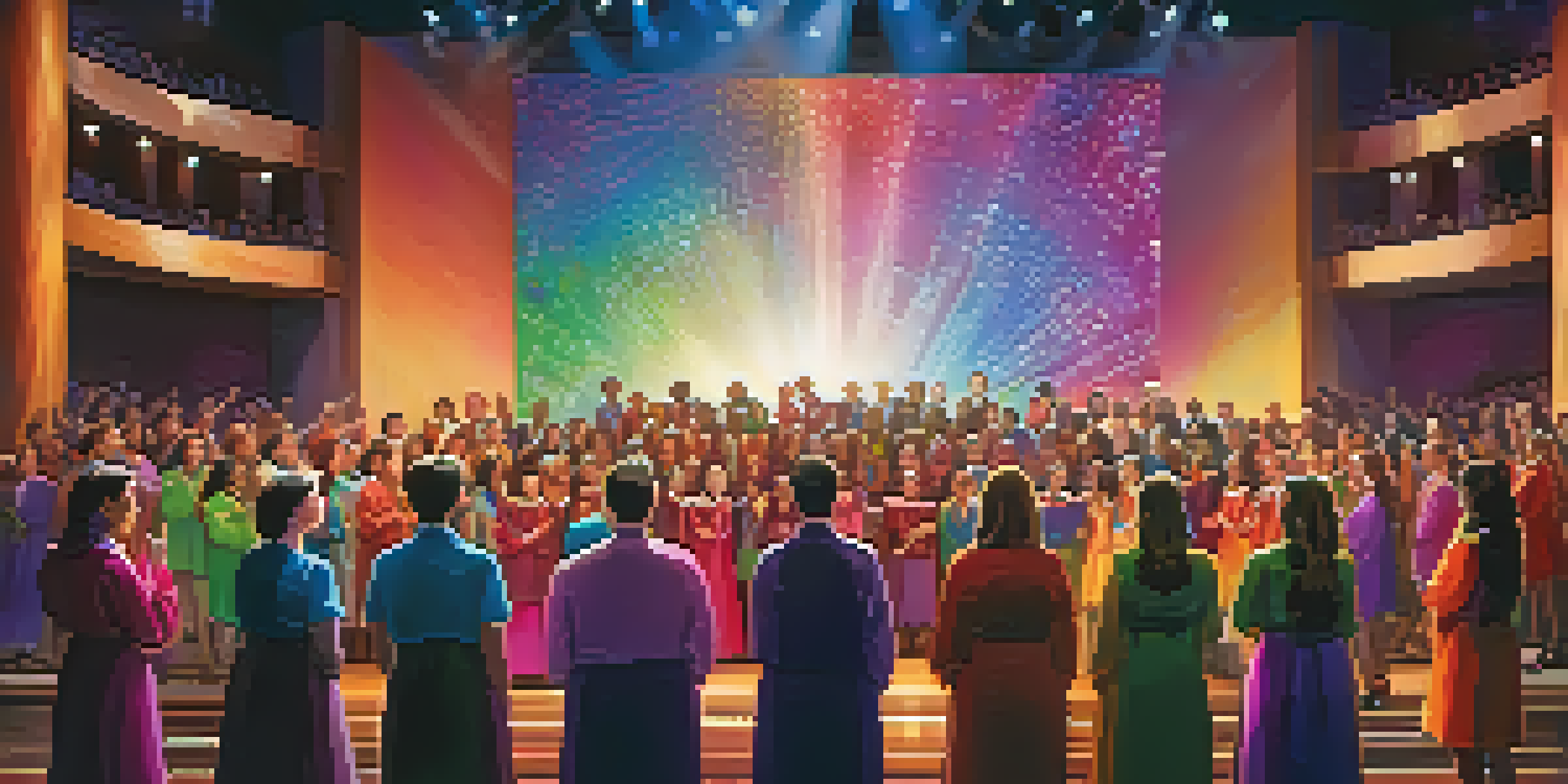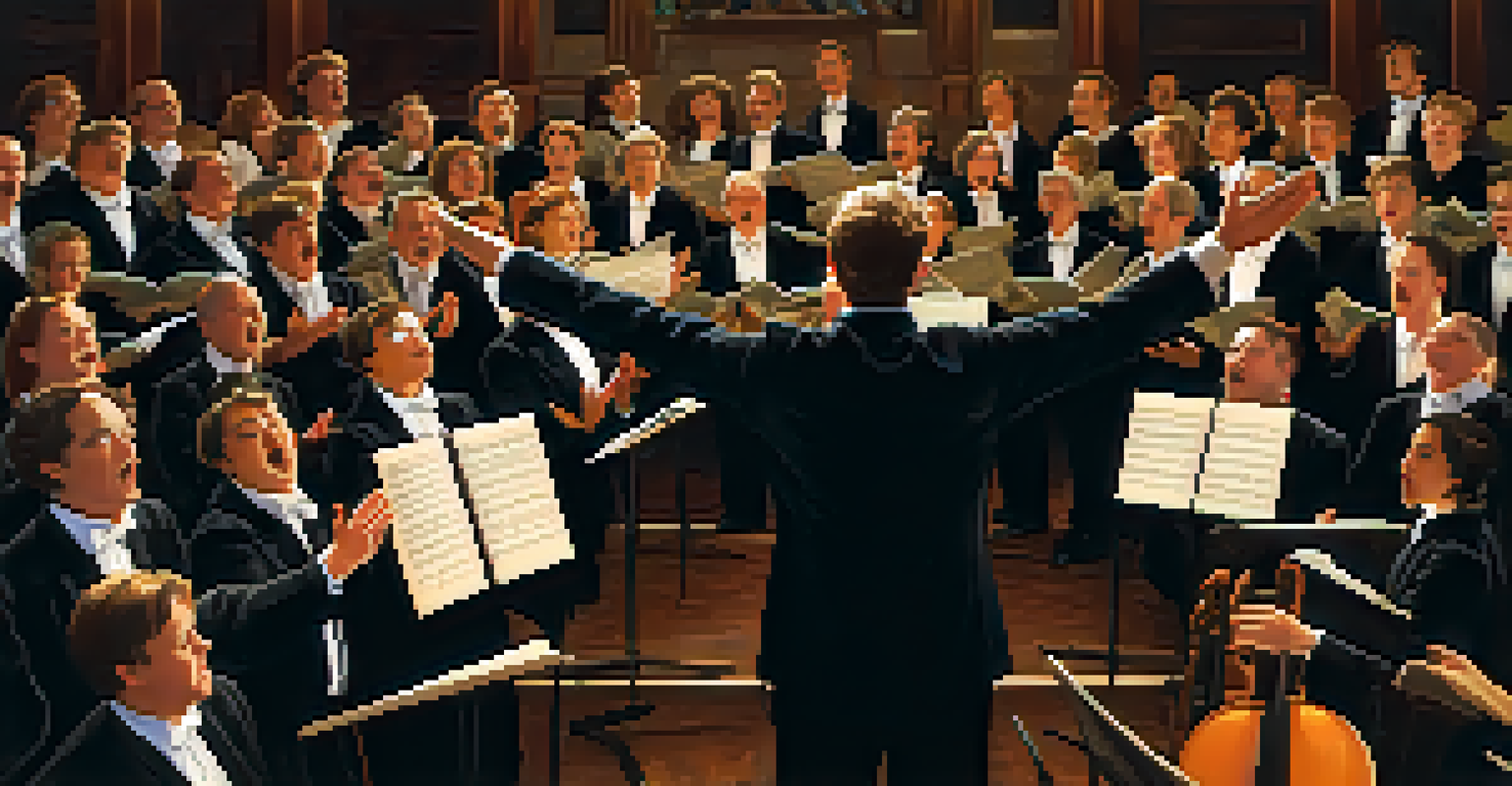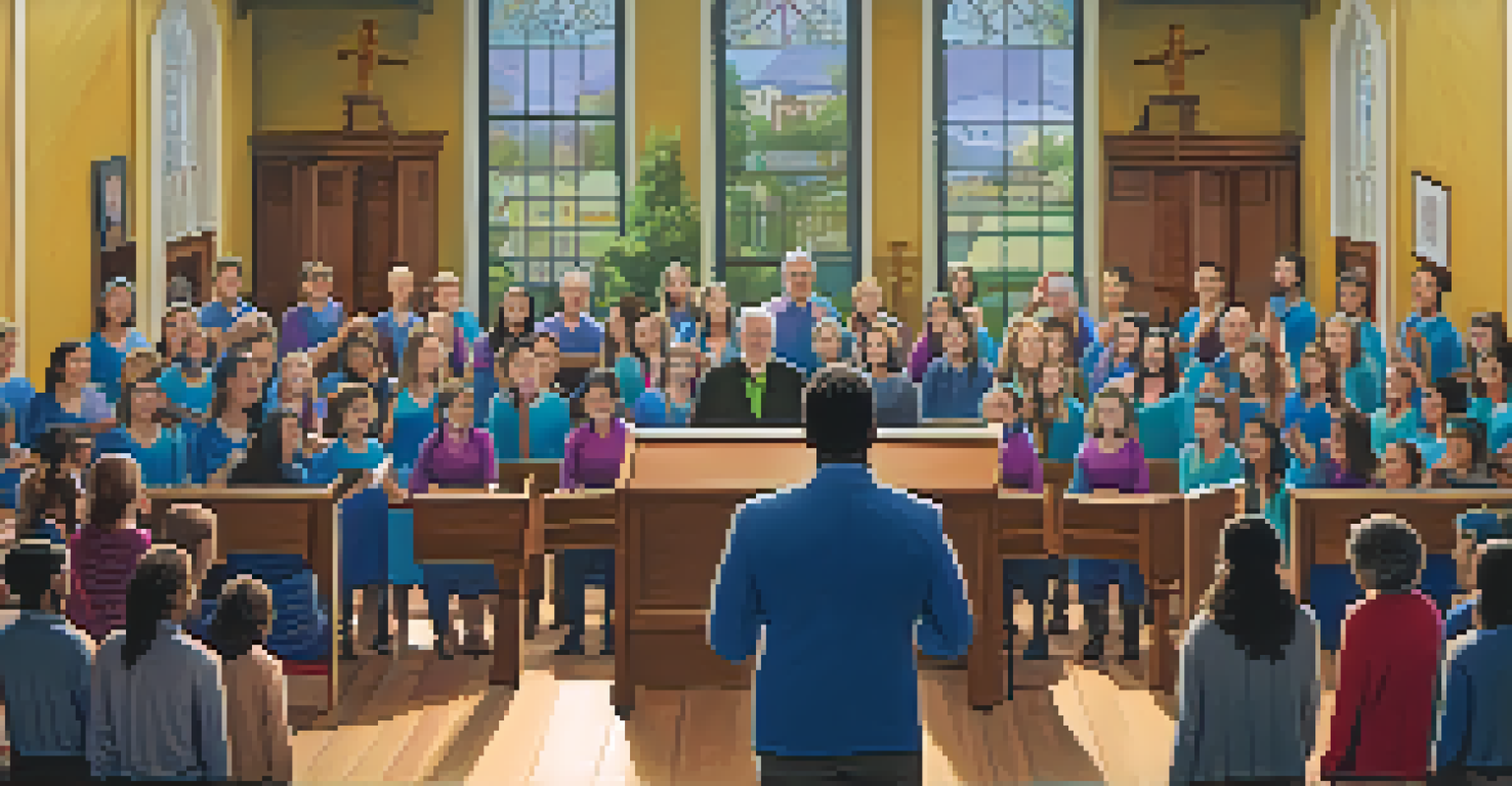The Role of Technology in Modern Choral Music

The Evolution of Choral Music Through Technology
Choral music has come a long way from its traditional roots, evolving with the times. In the past, choirs relied heavily on printed scores and live performances, but technological advancements have introduced new dimensions. Today, digital platforms allow for instant sharing of music, enabling choirs from different parts of the world to collaborate effortlessly. This evolution has reshaped how we perceive and perform choral music.
Music can change the world because it can change people.
With the rise of audio and video recording technology, choirs can now document their performances and share them widely. This not only helps in promoting their work but also allows for critical self-assessment and improvement. For instance, a choir in New York can easily send recordings to a composer in London for feedback, creating a global dialogue about choral music.
Moreover, technology has facilitated the creation of virtual choirs, where singers from various locations can come together to perform a piece. This innovative approach not only broadens the reach of choral music but also makes it accessible to those who may not have the opportunity to join a local choir.
Digital Tools for Composition and Arrangement
Composers today have an array of digital tools at their disposal, allowing for creative freedom and efficiency. Software like Sibelius and Finale enable composers to notate music quickly and make adjustments with ease. This means that the once tedious process of arranging choral pieces can now be streamlined, giving more time for creativity and experimentation.

Additionally, many composers are utilizing music production software to create rich, layered sounds that were once only possible in a studio setting. Programs like Logic Pro and GarageBand allow for the incorporation of various instrumental and vocal elements, giving composers the chance to experiment with their sound palettes. This has led to more innovative compositions that blend traditional choral elements with modern influences.
Tech Transforms Choral Collaboration
Advancements in technology enable choirs worldwide to collaborate easily and share their performances effortlessly.
The ability to easily share digital scores and arrangements through platforms like Noteflight and MuseScore fosters collaboration among composers and arrangers. This not only enhances creativity but also allows for a greater exchange of ideas within the choral community, pushing the boundaries of what choral music can be.
The Impact of Social Media on Choral Communities
Social media has transformed how choirs connect with their audiences and each other. Platforms like Facebook, Instagram, and TikTok provide spaces for choirs to showcase their talent, share behind-the-scenes content, and engage with fans. This engagement helps build a sense of community and can even attract new members or supporters.
Technology is best when it brings people together.
Through social media, choirs can also participate in global events and challenges, bringing together singers from various backgrounds. For example, the #VirtualChoir movement saw thousands of singers from different countries come together to perform a piece collaboratively. This kind of participation not only showcases the power of technology but also highlights the unifying nature of music.
Moreover, social media serves as a valuable tool for fundraising and promoting performances. Choirs can create events, share ticket links, and even host live-streamed concerts, making their music accessible to a broader audience. This shift not only enhances visibility but also opens up new avenues for financial support.
Using Technology for Education in Choral Music
Technology plays a crucial role in the education of new generations of choral musicians. Online platforms like YouTube and Coursera offer a wealth of resources for learning music theory, vocal techniques, and conducting. This accessibility allows aspiring musicians to educate themselves at their own pace, breaking down traditional barriers to music education.
Virtual classrooms and online workshops have also made it possible for choirs to rehearse and learn from anywhere. With tools like Zoom and Google Meet, conductors can lead rehearsals even when singers can't be physically present. This flexibility is especially beneficial for school choirs and community groups that may have scheduling challenges.
Digital Tools Enhance Composition
Composers now utilize digital software for efficient music notation and innovative sound creation, pushing creative boundaries.
In addition, apps designed for practice and learning, such as SingSharp and SmartMusic, provide singers with instant feedback on their pitch and timing. This real-time assistance helps singers improve their skills more effectively, making technology an invaluable partner in musical education.
The Rise of Streaming and On-Demand Performances
Streaming services have revolutionized how audiences experience choral music. Platforms like YouTube, Spotify, and even dedicated streaming services for classical music allow listeners to access a vast library of performances at any time. This convenience has the potential to broaden the audience for choral music beyond traditional concert-goers.
Many choirs are now embracing live streaming as a way to reach audiences who cannot attend performances in person. This has become particularly important in recent years, as choirs look for new ways to connect with their communities. By live streaming concerts, choirs can engage with fans in real-time, fostering a sense of connection and interaction.
On-demand performances also provide choirs the opportunity to showcase their work indefinitely. By recording and uploading performances, choirs can create a digital portfolio that highlights their talents and repertoire. This not only serves as a promotional tool but also preserves their artistry for future generations.
Enhancing Performance with Sound and Lighting Technology
Modern choral performances are increasingly incorporating advanced sound and lighting technology to enhance the audience's experience. High-quality sound systems ensure that every note is heard clearly, regardless of the venue's size. This is especially crucial for large choirs, where maintaining balance and clarity can be challenging.
Lighting technology also plays a significant role in setting the mood for performances. Dynamic lighting can highlight specific moments in a piece, creating a more immersive experience for the audience. For instance, a dramatic change in lighting can accompany a powerful climax, heightening emotional impact.
Streaming Expands Audience Reach
Streaming services allow choirs to reach broader audiences and showcase their performances anytime, enhancing visibility and engagement.
Additionally, technology allows for creative staging and visual elements that were not possible before. Projection mapping, for example, can transform the backdrop of a performance, adding a layer of storytelling that complements the music. This fusion of sound and visual art elevates choral performances to new artistic heights.
The Future of Choral Music in a Tech-Driven World
As we look to the future, it's clear that technology will continue to shape the landscape of choral music. New tools and platforms are constantly emerging, offering fresh opportunities for collaboration, education, and performance. This ongoing evolution invites both seasoned musicians and newcomers to explore new creative pathways.
The integration of artificial intelligence and machine learning in music composition and performance analysis is already beginning to change how choirs approach their craft. For instance, AI can analyze a choir's performance and suggest areas for improvement, providing valuable insights that can enhance overall quality.

Ultimately, the fusion of technology and choral music has the potential to create a more inclusive and diverse musical environment. By embracing these changes, choirs can reach broader audiences, explore new artistic expressions, and continue to thrive in a rapidly changing world.